retrieved from the 'Aspects of South Shields' website (defunct)
retrieved from the 'Aspects of South Shields' website (defunct) |
This pub situated on Marsden beach is well known to the folks of Shields, but it has fallen on hard times , and at the time of writing ( November 2001 ) it is closed down. Fortunately it has been bought by a company and they are to refurbish it at a substantial cost ~ lets hope they succeed . The history of this pub is quite unique and what follows is how it came into being .
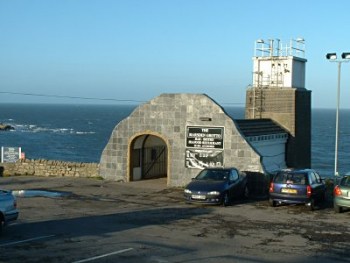 |
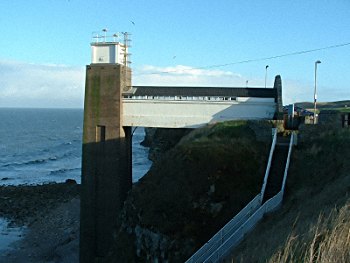 |
|
| Entrance to the Grotto pub in 2004 , well worth a visit if you are visiting the area . | The Grotto steps to and from the Pub - do not use these unless you are feeling fit . 2004 |
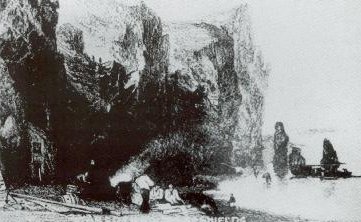 |
 |
|
Marsden Grotto and Needle Rock
1820 |
Marsden Rock ca. 1955 |
Marsden Bay was for many years a favourite spot for smugglers as the caves in the area were perfect for storing contraband . It was in 1782 that "Jack the Blaster" , originally an Allenhead miner , gained employment at Marsden Quarry's and set up home in one of these caves .
Jack the Blaster
Quarry man . poacher , and smuggler ,
Jack lived in the cave at the foot of stairs by Marsden Rock . These stairs
were reputedly built by Jack himself and became known around the area as " Jack
the Blasters Stairs " . It was at the ripe old age of 80 that Jack and his wife
had retired to the cave . The novelty of this situation drew many people to the
area to see the original "Odd Couple "
and Jack and his wife supplied their visitors with refreshments . Carriages
drove to the Grotto to partake in the couples hospitality , at a price , a
forerunner to the present day pub and restaurant . Jack also found the local
smugglers good customers since he was in an ideal place to assist them
.
Jack,s Early Abode
Peter Allen
Although born in Tranent , East Lothian , Scotland , the Allan's moved to NE England when Peter was a young lad. His Father was for many years gamekeeper to Sir Hedworth Williamson , Lord of Whitburn Hall . Young Peter , while quarrying stone for the lime kiln at Marsden , had the bright idea of setting up home in the caves and selling refreshments to the numerous picnic parties who visited the area . After winning a considerable amount of money at the South Shields races , Peter bought a tent and pitched it at the end of the lane from Cleadon to Marsden Bay . The refreshments he sold from the tent financed him as he set about excavating the cave where Jack the Blaster had worked before him . He soon fell foul of the Excise authorities who saw in his labour not the work of an entrepreneur , but the work of a smuggler . There was an element of truth in this as , even as late as 1851 , the " Rob Roy " ( a former revenue Cutter turned smuggling Schooner ) was captured with 8000 lbs ( 3,636 Kg ) of contraband tobacco worth at the time some £4000 ( more than £600,000 by today's standards ) , while a further 600 lbs ( 273 Kg ) were seized in a cave where it had just been landed - a substantial haul . The Excise Supervisor was from South Shields and threatened to close down Peter's business as he had no license to sell ale and porter . Peter applied to the Magistrates for an Ale & Spirit license but found great difficulty in obtaining one . Eventually the Shields Magistrates granted him a licence but the opposition to his venture did not dissolve . The excise authorities appointed a special reinforcement for the Coast Guard in Marsden Bay , however as Peter was such a likeable and jovial fellow , he soon was on the best of terms with Preventative Officers . Peter could now concentrate on improving his home and prospects by building an ascent to the summit of the big rock itself so that visitors could climb to the top . Thousands of people used the ladders Peter had built even though far from safe . In the course of excavation some 18 skeletons were unearthed by Peter and the unemployed pitman who assisted him . Most were thought to be smugglers who failed to survive their precarious occupation ! . The work continued and eventually the hole in the rock began to look more like an Inn .
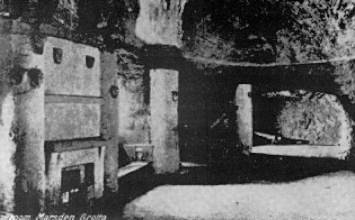
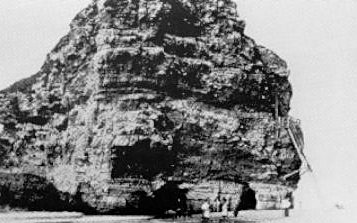
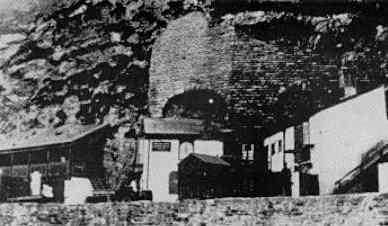
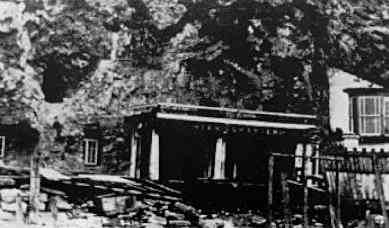
The First Detailed Description of the Grotto
A writer in 1848 described the Inn in these words " Approaching from the sands you see the Grotto at the South Western angle of the bay , nesting at the foot of the upward rocks . It is two storeys in height . The front is plain , whitewashed wall of built stone , part of the roof is exterior to the rock and slated . Attached to the upper storeys are wooden balconies where visitors may sit in the free open sunshine and enjoy their pipe , biscuit , and glass of ale , and the beautiful prospects seawards , enlivened by the fleets bound for and from the Tyne . The great weather- beaten brow of the rock beetles threateningly overhead , and in the face of it , on one side of the cottage , a flight of steps , almost perpendicular , is cut in zig zag fashion from the footpath on the top to the embankment below . On the other appears a range of apertures , which , on further inspection , you ascertain to be dovecotes , whilst beneath these on the ground floor , so to speak , is a row of massive grated windows and doors , which you will guess admit air , light and access anything but a ballroom , yet such is the case . Entering the Grotto you are hailed by Peter with one of his blithest smiles , and invited forthwith to take peep at the interior . This comprises eight dwelling apartments , besides the ballroom . In the latter , a very spacious apartment , with vaulted roof , and rude orchestra at one end - in truth , as curious a salle de danse as " fair women and brave men " could fancy - the rock meets you on all sides ; in the former , in all but one . In one place the superincumbent rock is supported by pillars left in fact as the surrounding mass was hewn away ; and as two thirds of the room at least are furnished with doors , the whole is thoroughly ventilated . The height of the entire excavation is about 20 ft , its breadth (i.e. into the solid ) little under 30 ft and its length , from the end of the ballroom to that of the cottage , about 120 ft ."
To the south of the Grotto was a large cave . Peter drove a shaft to the summit to help him bring goods down to the Grotto . It became known as the Smugglers Hole . Chambers Journal of 1875 told the following story :
" A certain noted smuggler had arranged for lugger to discharge its cargo here . As the time arrived at night that the vessel ought to be approaching the coast , and a signal from the cave to indicate safety , a man long suspected of treachery was missing . The smuggler , therefore , to warn the skipper to keep away , set his dogs barking and let off his gun , which brought the Coastguard down (who turned out to be close by ) but who were told by the smuggler that thieves had attempted to enter the hut . The skipper , taking the hint , had sheered off . The officers then made for South Shields , and there found the vessel next day , entered her , and seized some 30 casks of " Tobacco" - no - but of Bilge water . The facts were that , upon receiving the signal , and knowing that the legal posse were collected elsewhere , the Captain had tacked about , and the cargo was landed in a lonely cove near Souter Point where it was packed , after the fashion of Beetroot , in an open field , which officers passed for days after without the knowledge of the prize within their reach . A few mornings after , their attention was roused by the sudden removal in the night of this heap , and then and not until then , they recollected that its formation was equally mysterious . The story would not be complete without its touch of horror . For years after, moans were heard to proceed from this hole in the cliff , and no one would approach or pass it after nightfall . The cause assigned for these lamentations was that the smuggler who attempted to betray the Gang , being caught , was placed in a tub , and hauled up by rope under the pole , and only let down once per day to receive some scant food and the gibes of his mates , his situation being rendered yet more cruel from his position permitting him to witness his comrades feasting and being made a target for the refuse of their festivities . "
Fatal Attraction
Death was never far from Peters abode and even today lives are lost in the area of the Grotto . In 1836 workmen found a skeleton with a leaden bullet lodged within the ribcage proving beyond doubt that Marsden was indeed a violent place in days gone by . Visitor's have been cut off by the tide and many a life has been lost trying to scale the treacherous rock face .
Peter's Last Fight
Although Peter had lived in the Grotto for 22 years , a law suit to evict him and his family was brought by John Clay in 1848 . At the eventual hearing Peter was forced to pay £50 costs and an annual rent of £10 on a 20 year lease . This totally shattered Peter who sank into a deep depression . He died on the 31 st August 18499 aged 51 years , leaving a wife , 5 sons & 3 daughters . He was buried in Whitburn Churchyard and on his Gravestone was written
Sacred
To the Memory of Peter Allan
Of Marsden Marine Grotto
Who Died August 31st 1849
Aged 51 years
Universally Respected
God is my Rock. And my Salvation
After Peter
Peters children continued the excavation and improvement of the Grotto and during this period the Grotto was almost destroyed by a great cliff fall in 1865 . Major repairs and excavations were required and huge retaining walls and buttresses on the cliff face were built . The Allan Clan vacated the Grotto in 1874 after some 35 years of hard work and battles against authority and elements .
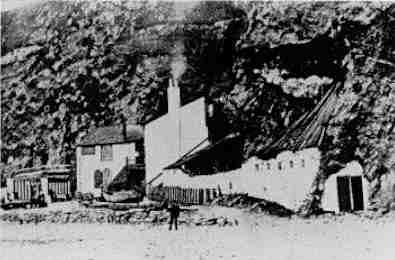

The Ghost of the Grotto
One day a smuggler walked into the Grotto Inn off the beach and ordered some ale . He was still drinking at the bar when a soldier entered. The smuggler , mistaking the soldier for a Customs Officer , flattened him , and took to his heels along the beach . Getting to his feet , the soldier raised his musket and discharged its load hitting the fleeing smuggler in the back of the neck . He fell to the sand - stone dead . The landlord drained the the mans tankard and nailed it directly onto the cavern rock around the bar saying "This tankard is cursed . Let no man drink from it otherwise evil will befall them too ! " . From that night on , the ghost of the smuggler visits the Grotto Inn . So often has it been seen that landlords have left a drink in the tankard at night and by morning it has been drunk !! .
The Grotto in the 20th Century
The Whitburn Coal Company , later to become The Harton Coal Company , bought a large percentage of the land around Marsden including the Grotto . A new tenant was installed in the Grotto who went by the name of Sidney Milnes Hawkes , Barrister and Doctor of Law as well as a confirmed gambler . Hawkes departed to live in Bruge and was succeeded by several tenants who gradually allowed the once famous Grotto to degenerate until in 1898 the Grotto was taken over by Messrs C.Vaux & Sons Ltd . This excellent local brewer turned out some wonderful beers ,Double Maxim to name but one , but in 2000 the Brewery was closed down under very emotional circumstances . It would appear that there were no financial problems and no lack of orders , but that the Vaux Board of Directors wished to get out of Brewing . Fortunately their famous beers are starting to reappear in the shops , but brewed by other companies .
Vaux and the Grotto
When Vaux took over the Grotto the caves were littered with scores of empty beer barrels , the property of firms who could not be bothered to retrieve them . All the beer had to lowered from the cliff top and many of the empty barrels simply floated away on the ebb tide . Vaux cleaned up the Grotto and in 1938 decided to purchase it outright . Some £12,000 were set aside for refurbishment's . A huge sum at the time .
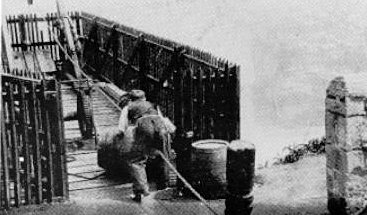 |
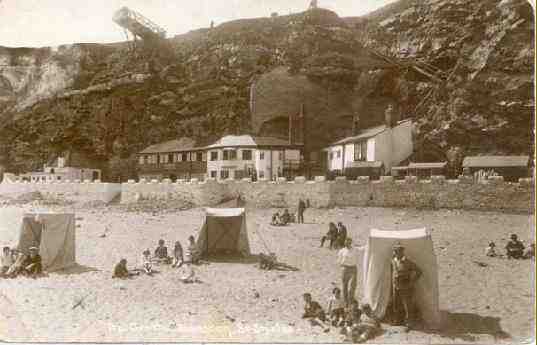 |
| A Draymans nightmare circa 1938 - lowering beer down to the Inn | Grotto circa 1931 - Courtesy of Ken Harvey |
 |
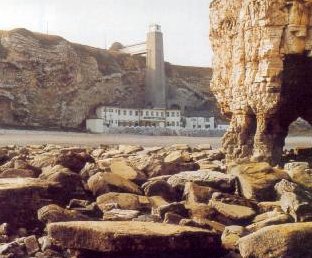 |
|
Rock to north of Marsden Rock |
Grotto 1948 with lift in
place |
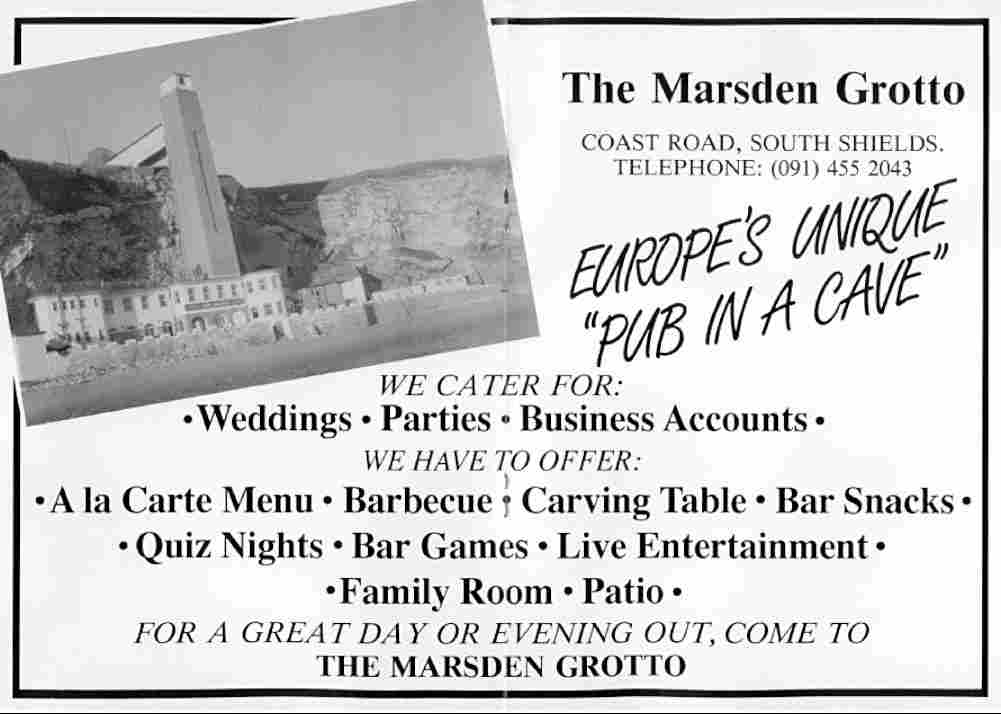 |
|
The Grotto in its Hey
Day |